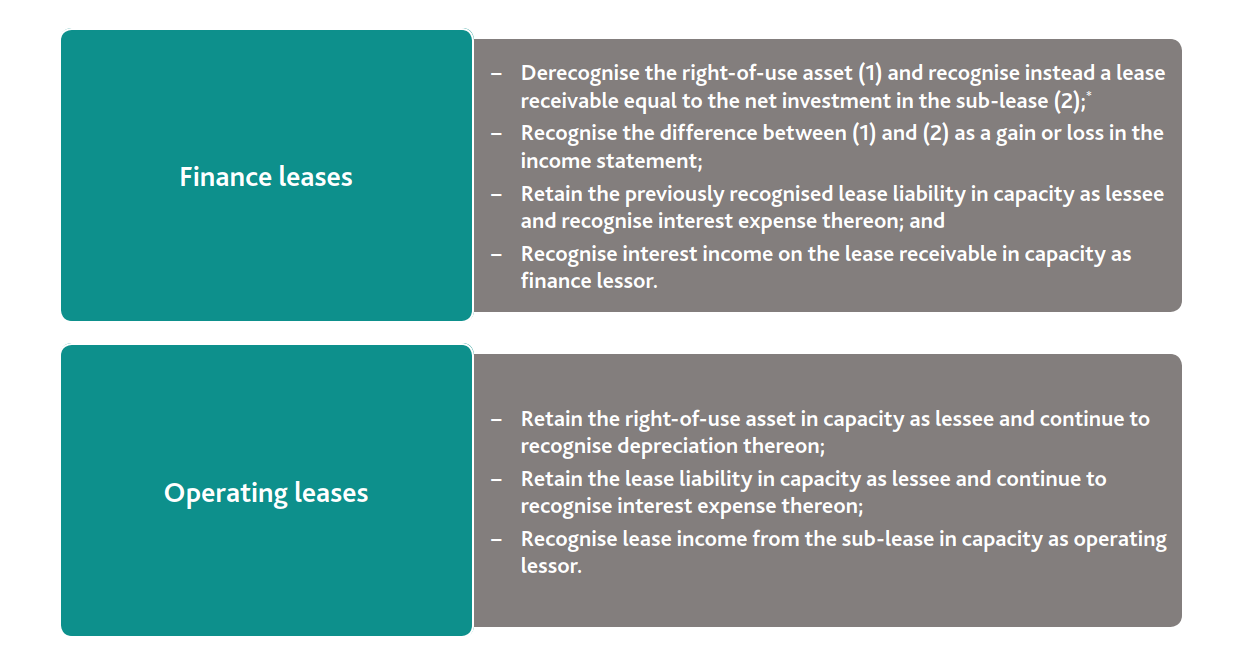Accounting for leases as a sub-lessor under IFRS 16
Previous Accounting Alert articles have highlighted some of the complexities associated with adopting IFRS 16 Leases for lessees for years ending 31 December 2019 onwards.
Lessors on the other hand do not have as much transition work to do on adopting IFRS 16, as IFRS 16 carries forward the operating lease and finance lease accounting previously contained in IAS 17 Leases for lessors.
However, the change in accounting treatment under IFRS 16 for lessees may now mean that certain sub-leases that would have previously been classified as (simple) operating leases, may now instead be finance leases.
This is because when assessing the classification indicators, the “asset being leased” is now the (new) Right-of-use asset (RoU asset) that has been recognised with respect to the (head) lease agreements as lessee, rather than the actual, physical asset being leased (i.e. the property itself). As the RoU asset may have a much shorter useful economic life, the classification of the sub-lease by the sub-lessor may differ from that of the head lessor.
Because of this change in assessment of the asset being sub-leased, certain significant indicators that a sub-lease is a finance lease may be more easily met than occurred under IAS 17.
When adopting IFRS 16, a sub-lessor must re-assess all its sub-leases to determine whether, (under IFRS 16) they are operating leases or finance leases, and thus whether a change in accounting treatment is required.
In summary, the accounting treatment required for a sub-lease depends on its classification by the sub-lessor as follows:

* A lessor uses the interest rate implicit in the lease to measure the net investment in the sublease. If the interest rate implicit in the sublease cannot be readily determined, the intermediate lessor may use the discount rate used for the head lease, adjusted for any initial direct costs associated with the sublease.
Example 1
Details:
- Entity A leases an office building for 5 years $100,000 per year (the head-lease).
- The remaining useful life of the building is 30 years, and the market value of the building is $2m
- Entity A sub-leases the office building, in its entirety to Party X on the same terms (i.e. 5-year term with lease payments of $100,000 per year) (the sub-lease)
(i) Prior to IFRS 16 (i.e. under IAS 17 Leases)
- The head- lease as lessee would likely have been determined to be an operating lease, as:
- The length of the lease (5 years) is not for a major part of the remaining useful life of the building (30 years).
- The present value of the gross $500,000 of lease payments is not substantially all of the fair value of the building ($2m).
- The sub-lease as sub-lessor would have likely have also been determined to be an operating lease, for the same reasons as above.
(ii) Subsequent to IFRS 16
- The head- lease is recognised on-balance sheet in accordance with IFRS 16, resulting in the recognition of a RoU asset, and corresponding lease liability by Entity A.
- The sub-lease is on (substantially) the same terms as the head-lease.
- In terms of the (relevant) indicators of operating versus financing lease under IFRS 16:
- The lease term is for a major part of the economic life of the asset being sub-leased– i.e., the RoU asset – being 5 years out of 5 years.
- The present value of the sub-lease payments are substantially all of the fair value of the asset being sub-leased – i.e., the RoU asset – being $500,000 out of $500,000.
- Accordingly, the sub-lease in this case is almost certainly a finance lease.
- Entity A will need to derecognise the RoU asset, and instead recognise a lease receivable, and recognise interest income on the lease receivable in its capacity as finance sub-lessor
What happens if the head-lease has been classified by the sub-lessor (in capacity as lessee of the head lease) as a short-term lease?
When a head-lease is short-term and the sub-lessor takes advantage of the related practical expedient in IFRS 16 not to recognise short-term leases in its statement of financial position in its capacity as a lessee, the sub-lessor must classify the sub-lease as an operating lease.
For more on the above, please contact your local BDO representative.